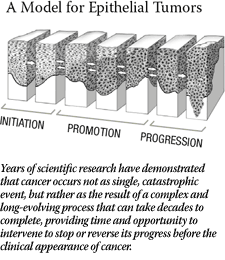
When the results of the STAR clinical trial were published last year, they showed that the anti-osteoperosis drug raloxifene was as effective at reducing breast cancer risk in high-risk women as tamoxifen, but with lower toxicity. The results also highlighted the evidence-based path prevention researchers follow to test more effective, less toxic agents.
That approach begins with NCI's chemoprevention agent portfolio. More than 108 agents are currently being tested in NCI-supported preclinical studies. And 100 unique drugs (alone or combined) have been or are now in early clinical trials.
While most of these compounds are in preliminary stages of research, other more established drugs are in large clinical trials. For colorectal cancer prevention, for example, results from two phase III clinical trials published last year demonstrated a significant risk-reduction benefit for people at increased risk of disease taking the COX-2 inhibitor celecoxib. However, the trials also raised significant concerns because of the cardiac toxicities associated with the drug in some participants.
"Once a treatment is proven to be effective, rarely is it abandoned because of toxicity concerns," said Dr. Asad Umar, acting chief of the Gastrointestinal and Other Cancers Research Group in DCP. "Instead, we do additional research to try to better understand the toxicities, hopefully finding ways to minimize them and improving the treatment's effectiveness. We approach prevention the same way."
 Celecoxib is already approved by the FDA for risk reduction, along with surgery, in people with familial adenomatous polyposis (FAP), a hereditary disorder that significantly increases colorectal cancer risk. And DCP's Dr. Iqbal Ali is using proteomic technologies to analyze blood from people with FAP to pinpoint molecular clues indicative of celecoxib chemopreventive activity and/or cardiovascular toxicity. "Our pilot study has identified novel celecoxib-modulated proteins of various molecular functions, some of which are highly relevant for carcinogenesis and cardiovascular pathology," Dr. Ali said.
Celecoxib is already approved by the FDA for risk reduction, along with surgery, in people with familial adenomatous polyposis (FAP), a hereditary disorder that significantly increases colorectal cancer risk. And DCP's Dr. Iqbal Ali is using proteomic technologies to analyze blood from people with FAP to pinpoint molecular clues indicative of celecoxib chemopreventive activity and/or cardiovascular toxicity. "Our pilot study has identified novel celecoxib-modulated proteins of various molecular functions, some of which are highly relevant for carcinogenesis and cardiovascular pathology," Dr. Ali said.
This research, she continued, is focused on identifying systemic changes after celecoxib treatment to identify which individuals at high risk of developing colorectal cancer are most likely to benefit from it.
The same approach is being used to try to refine the benefit-to-risk ratio of the first chemoprevention agent ever approved by the FDA, tamoxifen. Although recently published results have affirmed tamoxifen's preventive benefits and eased concerns about toxicity, prevention researchers are taking steps to further target its use.
Using blood samples from the breast cancer cases that occurred in the first large U.S. clinical trial testing tamoxifen for breast cancer prevention, the Breast Cancer Prevention Trial (BCPT), Dr. Barbara Dunn from DCP and Dr. Mark Greene from DCEG are leading a BCPT substudy, one of several directed by the National Surgical Adjuvant Breast and Bowel Project, that is examining a pre-identified set of genes, SNPs, and repeat sequences primarily in the cell-signal pathways for tamoxifen and estrogen metabolism. Their goal: to determine the impact SNPs have on tamoxifen or estrogen activity in preventing breast cancer.
"This is part of the movement toward individualized prevention," Dr. Dunn said. "Ideally, you would be able to genotype a woman not only to determine whether she is at high risk, but also whether she is likely to benefit from tamoxifen."
|